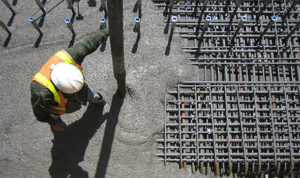
The use of colloidal silica in cement composites stretches back to work done by the US Army Corp of Engineers back in the early 2000 (Green 2004, 2012). Through wide spread use of the last decade, both the academic arena and construction industry have found that colloidal silica has the potential to increase strength and durability of concrete. One of the key benefits of using Colloidal Silica is the available surface area of the reactive silica. Due to the smaller particle size / corresponding increased surface area, the hydrating cementitious (cement) matrix of the concrete or grout will see the following:
· Accelerated Cement Dissolution: cement particles will dissolve faster due to the increased / accelerated growth induced by the smaller particles (Bjornstrom 2004)
· Instantaneous C-S-H polymerization, pozzolanic reaction, and seeds: the small size of the particle creates a much smaller force-field at the particle surface when compared to the force field of the silica fume in solution. B/c of this, the polymerization of C-S-H and pozzolanic induced C-S-H will occur faster and to a higher degree. The particles have also been shown to create seeds or nucleation sites for greater C-S-H growth (Land 2012).
· Pore water reduction, free alkali content reduction, reduction in permeability: There will be an increase in cement hydration, the type of C-S-H’s formed, and the reduction in pore water, free alkalis, and permeability of grout and concrete and grout specimens. This ultimately has an impact on the phase composition and chemical shrinkage of the hydrated cement matrix (Robertson 2013, Belkowitz 2015).
· Colloidal Silica has also been shown to have a effective impact on the reduction in Alkali-Silica reaction gel polymerization and expansion. The mechanism behind this increase in resistance to deleterious nature of ASR is recognized as a change in the environment needed for the ASR gel to consume constituents to polymerize. Furthermore, by reducing the pore structure, residual bulk water, and permeability the water and alkalis, expansion of the gel is also reduced (Said 2012, Belkowitz 2012, Said 2015). I have also included a portion of my PhD with the work conducted at ERDC; follow this link to the entirety of the published dissertation (Belkowitz 2015).
All that being said, b/c of the particle size and reactive surface there is a limitation to the amount of colloidal silica that can be used in a given mix. This dosage can be dependent on some of the following factors:
· Particle Size
· Cement/Cementitious Type
· Water Reducer Used
· Concrete / Grout Mixer Type
· Sequencing
Ultimately, our group and others across the world (both academic and industry) have seen in both the lab and field a significant potential to increase concrete strength and durability (Hou 2013, Belkowitz 2015, Supti 2015).
If you have any questions about concrete don’t hesitate to ask or leave a comment.
GO CONCRETE!!! BEAT asphalt!!!
Copyright Intelligent Concrete, LLC 2017
